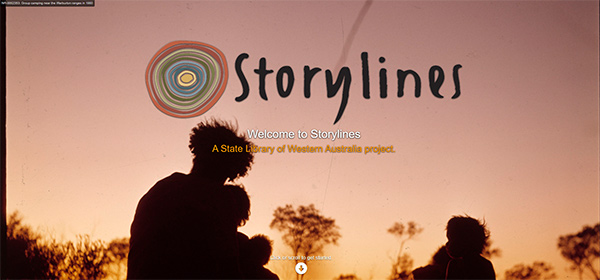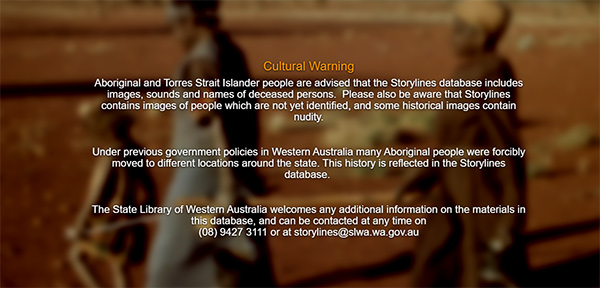Background
Libraries have undergone rapid and exciting changes in the last decade. Their role has expanded beyond traditional collecting and preserving practices, to utilising new digital technologies that actively engage communities and curate their collections. While these ongoing changes have been positive, there remains a considerable disconnect between galleries, libraries, archives, and museums (GLAM institutions) and Indigenous peoples.
Collections held in state and national libraries often represent the only (non-government) documentary heritage relating to the lives and stories of Indigenous people. Historically there have been many barriers between Indigenous people and these collections, such as:
- physical and geographical barriers for remote communities
- cultural and language barriers – literacy requirements for searching catalogues is sometimes quite high
- lack of awareness of the extent of Indigenous heritage collections held by libraries.
Storylines is a digitally-based project about breaking down these barriers, and understanding the importance of reconnecting this material to communities, families and individuals. This restores some balance to these collections and helps to create a deeper understanding around Western Australian history and the cultural knowledge of our first peoples.
The Storylines project has been built on the State Library of Western Australia’s (SLWA) experiences in working with regional and remote communities. It recognises the need to support Aboriginal communities and their collections, while also enabling ongoing access to the collections. Storylines has created an ideal pathway to realising a shift in the way in which Indigenous users access library facilities in Perth and in remote communities.
The Storylines project was inspired by the successful 1994 project Ara Irititja, which means ‘stories from a long time ago’. The Ara Irititja Archive was developed at the request of Ngaanyatjarra, Pitjantjatjara and Yankunytjatjara (Anangu) communities. Designed for the specific cultural needs of Anangu, the software protects and/or restricts access to private and sensitive materials, ensuring that cultural protocols of the community are a priority.
Some of the tangible outcomes of Ara Irititja expressed by Anangu include:
- an expanded sense of personal history and cultural traditions for all generations
- an appreciation of the role of Information Technology (IT) in the preservation of personal and community knowledge
- the opportunity to use IT
- enhanced individual and community wellbeing
- the transfer of new skills, educational capabilities and resources for the benefit of all levels of the community and organisations.

Current state
In 2013 SLWA launched the Ara Irititja (now Keeping Culture KMS) project – Storylines. Under the guidance of an Aboriginal reference group, Storylines seeks to:
- create a central access point for families and individuals to access the library’s vast Aboriginal documentary heritage collections, and a mechanism for the return of this material
- support community-based collections of local material, history and knowledge that can be managed according to local protocols and ways of working
- develop and support digital and information literacy outcomes for Aboriginal families, organisations and communities.
The Storylines project has two streams: the ongoing management of a central archive, and the establishment of community-controlled archives. The central archive is run by SLWA Storylines staff and caters to the entire state. This archive is generally open access but has the capacity to restrict access to sensitive materials such as secret/sacred collection content.
Currently SLWA has established two community-controlled archives, the first in Mowanjum community managed by the Mowanjum Artists Spirit of the Wandjina Aboriginal Corporation (Mowanjum Art and Cultural Centre) in 2014 and the second in Broome managed by Nyamba Buru Yawuru in 2015. These keeping places are separate from the central archive and are intended to house local and culturally-sensitive material. The community archives are established with local authorities and according to any cultural protocols which may be required.
The community-managed archives are comprised of digitally-repatriated content from SLWA collections as well as personal and repatriated artefacts and photos from private collections and organisations such as AISTSIS.
Both community controlled archives seek to prioritise:
- community governance
- training and employment of local workers
- populating the database: adding photos and tagging, adding information relating to traditional song and dance, and adding personal profile information
- community engagement.
The keeping culture software has a broad and relational knowledge structure which allows for the digitised images of objects, people, places, stories, plants, animals and technology to be tagged and linked to create vast knowledge profiles which reflect the many languages, stories and perspectives of Aboriginal Western Australia.
Through workshops and outreach work with Aboriginal families and communities, the State Library is slowly identifying many of the stories and people behind the thousands of photographs in our heritage collections. While more than 1700 people have been identified, community help is needed to identify hundreds of unknown photographs.

Outcomes
Core outcomes of Storylines program:
- connects Western Australians to SLWA collections
- connects SLWA to community and external collections (across institutional, private and community)
- learning opportunities – community learning about collections, SLWA learning through to digital literacy acquisition (two-way aspect).
In early 2015 the library commissioned Dr Inge Kral from the Australian National University to evaluate the development and impact of Wurnan Storylines, the community-controlled archive managed by Mowanjum Art and Cultural Centre. The report shows that the project has had a number of positive impacts in the community including:
- providing a pathway for the digital return of Indigenous collections from institutions and individuals
- generating training and meaningful employment for young people
- being a focal point for community engagement
- bringing joy to Indigenous families through the reconnection to unknown family photos and documents
- reawakening and sustaining cultural memory
- reviving cultural performance and practice from recordings held in Storylines
- establishing a synergy between cultural revival and young people’s multimedia activity.
Storylines is allowing for communities to reclaim their history, build community memory and is a platform for building multiple skills and literacies.
Materials are being digitally returned and Aboriginal clients can access the vast collections in their own time and on their own terms.
By actively removing barriers we are seeing the following benefits:
- people returning with confidence and becoming lifelong learners
- the platform is helping to overcome feelings of helplessness and voicelessness
- helping to restore trust between government and community.
Over the past six years Storylines has made more than 8200 images accessible, while 5800 Aboriginal and Torres Strait Islander people have now been identified in the collections.
Lessons learnt and challenges ahead
The continued growth of the central Storylines database and rollout of community databases requires significant ongoing investment from SLWA, participating communities and potential external sponsors. Work across the organisation and in collection management areas in particular is required to embed Storylines, cultural values and protocols in workforce and strategic planning.
The retention of Indigenous staff is required to promote the importance of Indigenous experiences, stories and knowledge in relation to SLWA collections. This will amplify Indigenous voices within the organisation, ensuring self-determination and community consultation.
Addressing the digitisation of collections that have been previously incorrectly catalogued, described in non-culturally sensitive ways or made publicly accessible online when their content is culturally sensitive is a significant and necessary piece of work ahead. SLWA acknowledges that there is cultural material held within our archive that is currently unknown due to the volume of collection material. We need to ensure that we work together as an organisation to fully understand the provenance and stories of the material we hold, give Aboriginal peoples the option to be there when this work is carried out and, respect their moral rights in relation to collections which hold their history and stories.
Related links
Dolord Mindi at Mowanjum Aboriginal Art and Cultural Centre – Digital Access to Collections
Relevant ATISLIRN Protocols
Protocol 3: Intellectual property
Protocol 6: Secret or sacred materials, or sensitive









